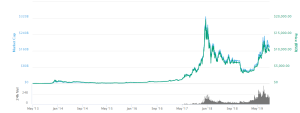Understanding Bitcoin’s Volatility: A Deep Dive into Price Fluctuations
Unleash the secrets of Bitcoin’s price swings! Learn to navigate the volatile crypto market and make smarter investment decisions. Understand the factors driving Bitcoin’s wild price fluctuations – from news events to regulatory changes. Become a Bitcoin expert today!
The cryptocurrency market, particularly Bitcoin, is notorious for its volatility. Prices can swing wildly in short periods, leaving investors both exhilarated and terrified. Understanding the forces driving these fluctuations is crucial for anyone considering investing in Bitcoin. This article delves into the complexities of Bitcoin’s price movements, exploring various factors that contribute to its upward and downward trends. We’ll examine historical data, analyze current market conditions, and speculate on potential future scenarios. Ultimately, we aim to provide a comprehensive overview that helps readers navigate the unpredictable world of Bitcoin.
The Complex Dance of Supply and Demand
At its core, Bitcoin’s price, like any asset, is determined by the interplay of supply and demand. When demand surges, exceeding the available supply, the price rises. Conversely, when demand weakens or supply increases, the price tends to fall. However, the dynamics within the Bitcoin market are far more intricate than simple supply and demand curves might suggest. Numerous factors influence both sides of this equation, creating a complex and ever-shifting landscape.
Regulatory Scrutiny and Government Policies
Government regulations significantly impact Bitcoin’s price. Positive regulatory developments, such as the establishment of clear legal frameworks for cryptocurrency trading, tend to boost investor confidence, driving up demand. Conversely, stringent regulations or outright bans can severely dampen investor enthusiasm, leading to price drops. The regulatory landscape is constantly evolving, making it a critical factor to monitor.
Adoption by Institutional Investors
The increasing adoption of Bitcoin by institutional investors, such as hedge funds and large corporations, has a substantial effect on its price. These large players can inject significant capital into the market, creating substantial upward pressure on prices. Their involvement lends a degree of legitimacy and stability to Bitcoin, attracting more retail investors and further driving up demand.
Technological Advancements and Network Upgrades
Technological advancements within the Bitcoin network itself can also influence its price. Successful upgrades that enhance scalability, security, or efficiency can boost investor confidence and lead to price increases. Conversely, major security breaches or significant network vulnerabilities could trigger price drops as investors lose confidence.
Macroeconomic Factors and Global Events
Bitcoin’s price is also sensitive to broader macroeconomic conditions and global events. Periods of economic uncertainty or geopolitical instability often lead investors to seek safe haven assets, such as gold or Bitcoin. This increased demand can drive up Bitcoin’s price. Conversely, positive economic news or a reduction in global uncertainty can lead investors to move away from Bitcoin towards more traditional assets.
Inflation and Monetary Policy
Inflationary pressures and central bank monetary policies significantly impact Bitcoin’s price. As fiat currencies lose purchasing power due to inflation, investors may view Bitcoin as a hedge against inflation, driving up demand. Changes in interest rates and quantitative easing programs can also influence investor sentiment towards Bitcoin.
Geopolitical Instability and International Conflicts
Geopolitical events and international conflicts can also influence Bitcoin’s price. During times of uncertainty, investors often seek safe haven assets like Bitcoin, driving up demand. Conversely, periods of relative global peace and stability may lead investors to shift away from Bitcoin towards other assets.
Market Sentiment and Media Influence
Market sentiment plays a crucial role in Bitcoin’s price fluctuations. Positive media coverage, optimistic analyst predictions, and general enthusiasm surrounding Bitcoin can lead to a surge in demand, driving prices higher. Conversely, negative news, pessimistic forecasts, and fear-mongering can trigger sell-offs and price drops.
Social Media Trends and Influencer Impact
Social media platforms have become powerful tools for influencing market sentiment. Tweets from prominent figures, viral memes, and online discussions can significantly impact Bitcoin’s price. Influencer marketing and social media campaigns can either amplify positive or negative sentiment, leading to corresponding price movements.
News Cycles and Market Manipulation
Major news events, both real and manufactured, can cause significant price swings. False rumors, coordinated attacks, or even well-timed press releases can manipulate market sentiment and trigger either buying frenzies or panic selling.
Predicting Future Trends: A Herculean Task
Predicting the future price of Bitcoin is a notoriously difficult task. The cryptocurrency market is highly volatile, influenced by a multitude of interconnected factors. While historical data and technical analysis can provide insights, they cannot accurately predict future price movements. The best approach is to understand the underlying forces driving Bitcoin’s price and to diversify your investment portfolio.
Fundamental Analysis vs; Technical Analysis
Two common approaches to analyzing Bitcoin’s price are fundamental analysis and technical analysis. Fundamental analysis focuses on the underlying value of Bitcoin, considering factors like adoption rate, network security, and regulatory developments. Technical analysis, on the other hand, uses charts and historical data to identify patterns and predict future price movements based on past trends. Neither method guarantees accurate predictions, but combining both can provide a more comprehensive view.
Risk Management and Diversification
Investing in Bitcoin carries significant risk. Its price can fluctuate dramatically, leading to substantial gains or losses. Effective risk management is crucial. Diversifying your investment portfolio across different asset classes is a key strategy to mitigate risk and protect your capital.
- Only invest what you can afford to lose.
- Do thorough research before investing.
- Spread your investments across different assets.
- Stay informed about market trends and news.
The Long-Term Outlook for Bitcoin
Despite the volatility, many believe Bitcoin has long-term potential. Its decentralized nature, limited supply, and growing adoption suggest a future where it plays a significant role in the global financial system. However, the path to widespread adoption will likely be bumpy, with periods of both significant growth and significant setbacks. The long-term outlook remains uncertain, but the underlying technology and its potential applications continue to evolve.
- Increased global adoption
- Integration with existing financial systems
- Development of new applications and use cases
- Improved regulatory clarity
Bitcoin’s journey has been characterized by dramatic ups and downs, offering both immense potential rewards and substantial risks. The factors influencing its price are complex and interwoven, making accurate prediction virtually impossible. However, understanding these influences – from macroeconomic conditions to social media trends – allows investors to make more informed decisions. Ultimately, navigating the Bitcoin market requires a balanced approach: thorough research, careful risk assessment, and a long-term perspective. The future of Bitcoin remains unwritten, a testament to its volatile and dynamic nature. Continuous learning and adaptation are key to successfully participating in this exciting, yet unpredictable, market. The potential for growth is undeniable, but so too are the inherent challenges. Wise investment decisions stem from knowledge, prudence, and a clear understanding of the inherent volatility.







